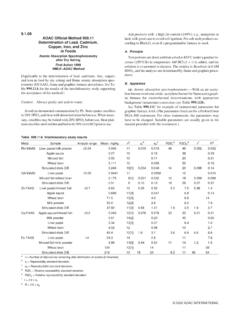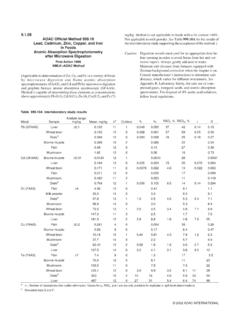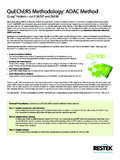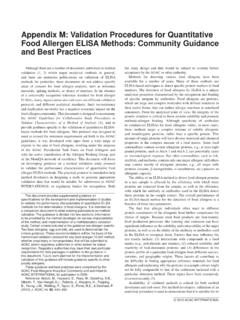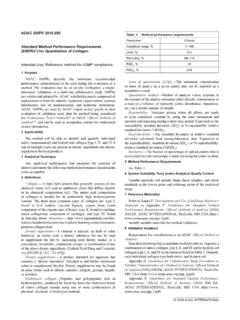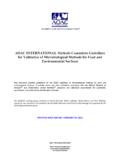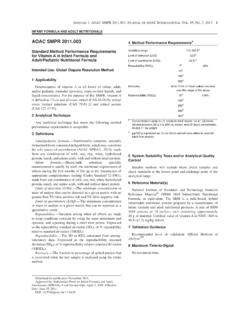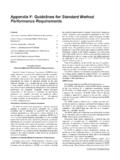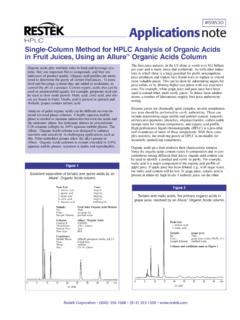Transcription of 9.1.09 AOAC Official Method 999.11 Determination …
1 Official Method of Lead, Cadmium,Copper, Iron, and Zincin FoodsAtomic Absorption Spectrophotometryafter Dry AshingFirst Action 1999 NMLK aoac Method [Applicable to the Determination of lead, cadmium, zinc, copper,and iron in food by dry ashing and flame atomic absorption spec-trometry (GFAAS), flame and graphite furnace the results of the interlaboratory study supportingthe acceptance of the Method .]Caution: Always gently add acid to environmental contamination by Pb. Store quartz cruciblesin 20% HNO3and rinse with deionized water before use. When neces-sary, crucibles may be boiled with 20%HNO3before use. Heat plati-num crucibles until red hot and boil with 50% (v/v) HCl prior to products with a high fat content ( 40%), , margarine orlard, with great care to avoid self-ignition. Pre-ash such products ac-cording toD(c)(2), even if a programmable furnace is PrincipleTest portions are dried and then ashed at 450 C under a gradual in-crease ( 50 C/h) in temperature.
2 6 MHCl (1+1) is added, and thesolution is evaporated to dryness. The residue is dissolved in , and the analytes are determined by flame and graphite Apparatus(a)Atomic absorption spectrophotometer. With an air acety-lene burner or nitrous oxide acetylene burner for flame and a graph-ite furnace for electrothermal determinations, with appropriatebackground (nonatomic) correction ( ). example of instrumental parameters forgraphite furnace AAS. (The parameters listed are for a Perkin ElmerHGA-500 instrument. For other instruments, the parameters mayhave to be changed. Suitable parameters are usually given in themanual provided with the instrument.) 2002 aoac INTERNATIONALT able Interlaboratory study resultsMetalSampleAnalyte rangeMean, mg/kgnasrbsRcRSDrdRSDRerfRgPb-HGAASL iver paste/milk powder diets [1] paste fish/wheat [1] diets paste/minced fish [3] [2] [2] diets [2] sauce/minced fish [1] [2] [2] diets [1] paste fish/milk [3] bran12413[1]141139 Simulated diets Number of laboratories remaining after elimination of outliers [in brackets].
3 Bsr= Repeatability standard Reproducibility standard Relative repeatability standard Relative reproducibility standard = = sR.(b)Hollow cathode, or electrodeless discharge lamps for all ele-ments determined.(c)Furnace. Programmable, or muffle furnace with thermostatmaintaining 450 25 C. If muffle furnace is used, a separatepre-ashing device is (d) (h).(d)Hot plate. With heating control, to heat up to about 300 C.(e)Lamp. IR 250 W, fixed to a retort stand in a way that allowsadjustment of the distance to the plate.(f)Ceramic plate. , Desiccator plate on a low stand, with adiameter that suits the hot plate.(g)Glass cover. , Crystallizing dish, 185 mm diameter,100 mm height, to fit on (f) or equivalent.(h)Wash-bottle. Scrubber, containing H2SO4for purifica-tion of assembly of items (d) (h).(i)Quartz or platinum crucibles. 50 75 mL.(j)Polystyrene bottles.
4 With leak-proof closures, 100 clean and rinse all glassware and plasticware withHNO3or HCl to avoid metal procedure forglass and plasticware. Acid solution: 500 mL concentratedHNO3,C(c) +4500 mL deionized water,C(a). Wash first with waterand detergent. Rinse with tap water, followed by deionized water,then with dilute acid. Finally rinse 4 5 times with deionized ReagentsReagents should be at least analytical reagent grade ( ), prefer-ably ultrapure (suprapur), or equivalent.(a)Water. Redistilled or deionized, resistivity 18 M cm.(b)Hydrochloric acid. 6M. Dilute 500 mL HCl (37% w/w)with water to 1 L.(c)Nitric acid. 65% (w/w).(d)Nitric acid. Dilute 7 mL HNO3,(c), with water, (a),to1L.(e)Lead standard solution. 1 mg/mL. Dissolve g Pb in7mLHNO3,(c), in 1 L volumetric flask. Dilute to volume with wa-ter. [Note: Commercially available standard solutions for AAS ( ,BDH Chemicals Ltd.)]
5 , Poole, UK) may be used for all metal standardsolutions.](f)Cadmium standard solution. 1 mg/mL. Dissolve g Cdin 14 mL water+7mLHNO3,(c), in 1 L volumetric flask. Dilute tovolume with water.(g)Zinc standard solution. 1 mg/mL. Dissolve g Zn in14 mL water+7mLHNO3,(c), in 1 L volumetric flask. Dilute tovolume with water.(h)Copper standard solution. 1 mg/mL. Dissolve g Cuin7mLHNO3,(c), in 1 L volumetric flask. Dilute to volume withwater.(i)Iron standard solution. 1 mg/mL. Dissolve g Fe in14 mL water+7mLnitric acid, (c), in 1 L volumetric flask. Dilute tovolume with water.(j)Working standard solutions. (1)For graphite furnaceanalysis. Dilute standard solutions, (e) (i), with HNO3,(d),to a range of standards that covers the linear range of the element tobe determined. (2)For flame analysis. Dilute standards, (e) (i),with HNO3,(d), to a range of standards that covers the concen-tration of the element to be Procedures(a)Pre-treatment.
6 Homogenize product if necessary, usingnoncontaminating equipment. Check for leaching metals if the ap-paratus consists of metal parts.(b)Drying. In a crucible, weigh 10 20 g test portion to g. Dry in a drying oven, on a water-bath, or a hot plate at 100 C,if there is a risk of heavy boiling in the ashing step. Proceed accordingto type of furnace.(c)Ashing. (1)Ashing in a programmable furnace. Placedish in furnace at initial temperature not higher than 100 C. Increasetemperature at a maximum rate of 50 C/h to 450 C. Let dish standfor at least8horovernight. Continue according to (e). (2)Ashing ina muffle furnace with thermostat following drying and pre-ashing inapparatus described inB(d) (h). Place cruci-ble with the test portion covered with the glass cover on the ceramicplate, and let purified air coming through a glass tube sweep over theproduct. Put IR lamp down at the cover.
7 Pre-ash product sample byincreasing temperature slowly with IR lamp by gradually increasingtemperature on hot plate to maximum. Final temperature on ceramicplate should then be about 300 C. Time required for pre-ashing var-ies with product. Put crucible in muffle furnace at 200 250 C andslowly raise temperature to 450 C at a rate of no more than 50 stand for at least8horovernight. Take crucible out of furnaceand let cool. Wet ash with 1 3 mL water and evaporate on wa-ter-bath or hot plate. Put crucible back in furnace at no more than 2002 aoac INTERNATIONALT able Instrumental parameters for flamedeterminationElementFlameWavelength , nmFeNitrous oxide acetylene, acetylene, acetylene, Example of instrumental parameters for graphite furnace AASM etalWavelength,nmTemperature programTest solutionvolume, LGraphite tubeStep 1 Step 2 Step 3 Step , 130 C6501900250020L vovRamp, 10 s502 Hold, 30 , 130 C3501200250010 UncoatedRamp, 1 s502 Hold, 19 s1022200 C and raise temperature (50 100 C/h) to 450 C.
8 Proceed withashing at 450 C for 1 2 h or longer. Repeat procedure until productis completely ashed, , ash should be white/grey or slightly col-ored. Number of repetitions necessary varies depending on type ofproduct. Add 5 mL 6 MHCl,C(b), to crucible ensuring that all ashcomes into contact with acid. Evaporate acid on water-bath or hotplate. Dissolve residue in mL, to the nearest mL, HNO3,C(d). Swirl crucible with care so that all ash comes intocontact with acid. Cover with watch glass and let stand for 1 2 stir solution in crucible thoroughly with stirring rod and trans-fer contents to plastic bottle. Treat blanks in the same way as prod-ucts. Include 2 blanks with each analytical batch.(d)Atomic absorption spectrophotometry. Pb and Cd in foodsgenerally require graphite furnace AAS for Determination . Zn, Cu,and Fe can, in most foods, be determined by flame , gas mixture/temperature program, and other instru-mental parameters that are most appropriate for each metal are foundin the manual provided with the correction must always be used in flameless AAS andfor flame applications at low results are outside of the linear range, the test solutionsshould be diluted with HNO3,C(d).
9 Flame technique. Prepare calibration curves from a minimumof 3 furnace (flameless) technique. The Method of addi-tion should always be used. Measurements must be made in the lin-ear range when Method of addition is used. Measurements arepreferably made with peak area rather than peak Calculations and Evaluation of ResultsDetection limit. Calculate the detection limit, DL, for eachmetal as:DL=3 standard deviation of the meanof the blank determinations(n= 20)Calculate the concentration, c, of metal in the test sample accord-ing to the formula: where c = concentration in the test sample (mg/kg); a = concentra-tion in the test solutions (mg/L); b = mean concentration in the blanksolutions (mg/L); V = volume of the test solution (mL); m = weightof the test portion (g).If (a b) is lower than the DL, then (a b) is substituted with DLfor calculation of the limit of detection in the test test solution has been diluted, dilution factor has to be taken intoaccount.
10 When running replicates, the average of the results shouldbe given with 2 significant :J. aoac , 1204(2000).Revised: March 2002 2002 aoac INTERNATIONALF igure Apparatus for pre-ashing of samples.
